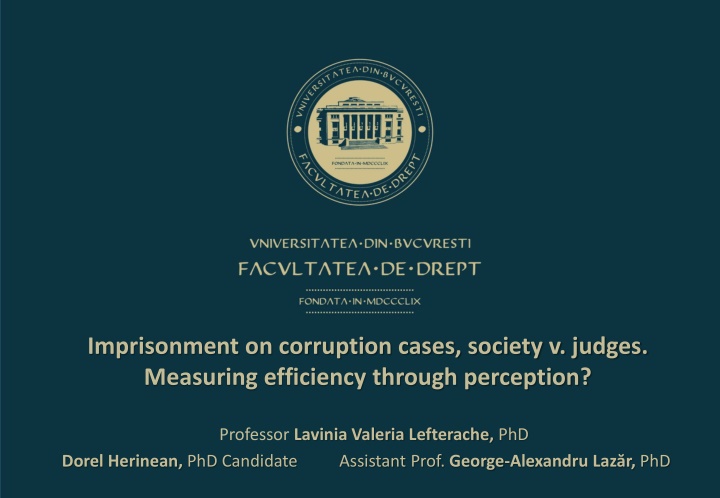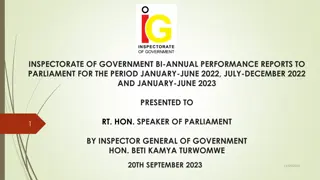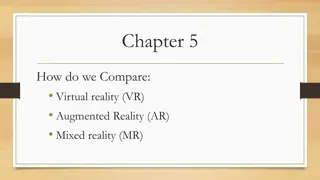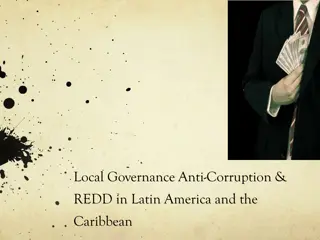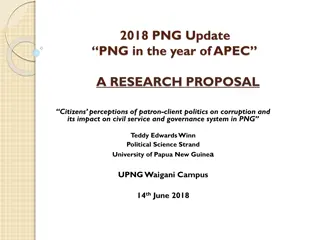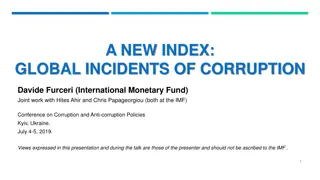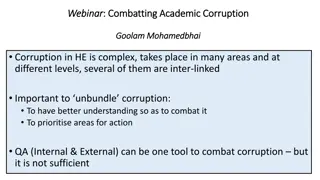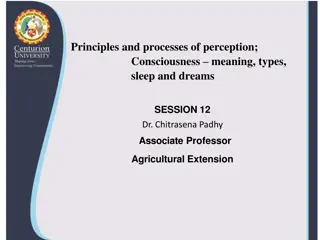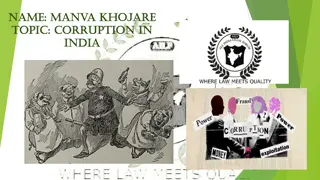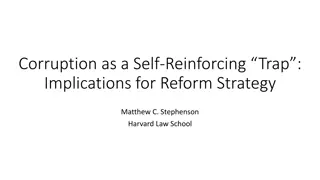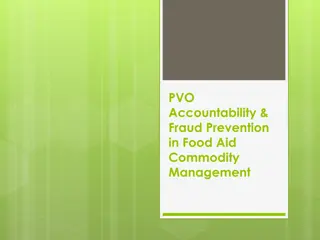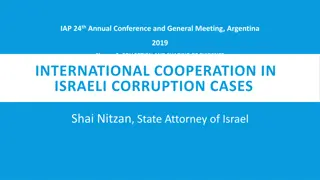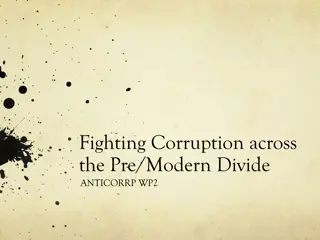Imprisonment Trends in Corruption Cases: Perception vs Reality
This study compares perceptions of the usefulness of sanctions in corruption cases with the actual lengths of imprisonment imposed by courts. It investigates the individualization of sanctions, societal expectations, economic influences, and the impact of the sanitary situation on sentencing decisions. The aim is to understand the gap between society's expectations and judicial reasoning in corruption cases.
Download Presentation

Please find below an Image/Link to download the presentation.
The content on the website is provided AS IS for your information and personal use only. It may not be sold, licensed, or shared on other websites without obtaining consent from the author.If you encounter any issues during the download, it is possible that the publisher has removed the file from their server.
You are allowed to download the files provided on this website for personal or commercial use, subject to the condition that they are used lawfully. All files are the property of their respective owners.
The content on the website is provided AS IS for your information and personal use only. It may not be sold, licensed, or shared on other websites without obtaining consent from the author.
E N D
Presentation Transcript
Imprisonment on corruption cases, society v. judges. Measuring efficiency through perception? Professor Lavinia Valeria Lefterache, PhD Assistant Prof. George-Alexandru Laz r, PhD Dorel Herinean, PhD Candidate
Abstract After three years of measuring students' perceptions of the usefulness of sanctions in corruption cases, we intend to compare these results with how the length of the imprisonment applied by of the courts of law has fluctuated over the same period. The study is to compare how the imprisonment has been individualized in the case of corruption offenses as they result from official statistics, how students in law perceive the individualization of sanctions (as result from a survey conduct over the last three years) and if the main economic indicators and the sanitary situation influence them both. The choice of the severity of the sanction affects not only the convicted person, but also the whole society. The way in which the society relays to the sanctions and the way in which they are understood by the court, the links between the economic fluctuations and the gravity of the punishments, and the state of emergency, the sanitary situation shall be examined in order to determine if there is a gap between the expectation of the society and the reasoning of the judges. The conclusion of the study aims to contribute to a better understanding of the role of imprisonment in designing public policies in this field. 2 Imprisonment on corruption cases, society v. judges. Measuring efficiency through perception?
Methodology 1. Formulating a question 2. Performing background research 3. Creating a hypothesis 4. Designing an experiment 5. Collecting data 6. Analyzing the results 7. Drawing conclusions 8. Communicating the results 3 Imprisonment on corruption cases, society v. judges. Measuring efficiency through perception?
Background and introductory remarks 1. Are the courts of law and the society on the same page on the severity of corruption offenses? 2. How do young adults perceive the prison penalty in Romania for corruption offenses? 3. How can we (or Should we?) use the perception of law students for designing public policies? 4 Imprisonment on corruption cases, society v. judges. Measuring efficiency through perception?
Background and introductory remarks 2014 Criminal Code diminished limits of prison terms increased field of alternative solutions large variety of criminal decisions in terms of limits and type 5 Imprisonment on corruption cases, society v. judges. Measuring efficiency through perception?
Corruption offences in Romanian Criminal Code Passive Bribery imprisonment 3-10 years + ban from the public function/profession used for committing the crime Active bribery imprisonment 2-7 years; The bribe giver shall not be punishable if they report the action prior to its discovery by the criminal investigation bodies. Influence peddling imprisonment 2-7 years Buying influence imprisonment 2-7 years; The perpetrator shall not be punishable if they report the action prior to its discovery by the criminal investigation bodies 6 Imprisonment on corruption cases, society v. judges. Measuring efficiency through perception?
The main penalties (juvenile not included) I.Life imprisonment cannot be imposed on persons aged more than 65 years; in such case, the sentence will be 30 years of imprisonment. Also, when a life prisoner turns 65, his or her sentence can be replaced with the 30 years penalty. II. Imprisonment from 15 days up to 30 years III. The fine (established on a day - fine system, between 300 Lei and 2,000,000 Lei (which equates ca. 60 400,000 Euro). All sentences have to be determined within these general limits Criminal Code and any other law defining further criminal offences provide a concrete sentencing range for each offence, which (almost) always remains within the general limits 7 Imprisonment on corruption cases, society v. judges. Measuring efficiency through perception?
Individual sentencing Based on a general provision on the principles of sentencing the court will determine and impose an individualized penalty Besides these legal rules, there are no guidelines setting a uniform determination of length of prison sentence 8 Imprisonment on corruption cases, society v. judges. Measuring efficiency through perception?
The Criminal Code further provides the possibility for the judge: to waive the enforcement of the sentence if the statutory penalty is less than 5 years and conditions are met, to postpone the enforcement of the sentence if the statutory penalty is less than 7 years and further conditions are met, one of these being that the offender agrees to perform community service to suspend the service of a sentence under supervision if the actual penalty imposed is a prison sentence of no more than three years. been previously convicted to a prison sentence of more than one year, except when rehabilitation has taken place or the deadline for rehabilitation has arrived, and an assessment of his or her personal qualification/background has to be made. In addition, the offender must agree to perform service. the offender must not have several further community 9 Imprisonment on corruption cases, society v. judges. Measuring efficiency through perception?
Sentencing2020 (juvenile offenders are not included) Sentencing2019 (juvenile offenders are not included) Fines: 4024 persons Fines: 4763 persons Imprison ment: 7208 persons Suspend the service of a sentence: 20498 persons Suspend the service of a sentence: 19638 persons Imprison ment: 7718 persons Total convicted persons: 32.979 Total convicted persons: 30.870 Source: http://statistici.insse.ro:8077/tempo-online/#/pages/tables/insse-table 10 Imprisonment on corruption cases, society v. judges. Measuring efficiency through perception?
Corruption cases convictions 10 year image People convicted each year Cateogries of crimes 2010 2011 2012 2013 2014 2015 2016 2017 2018 2019 2020 Total 41891 47577 49188 47133 40832 42276 32720 35396 32204 33683 31483 convictions Total corruption & offenses in public office 193 272 556 382 403 419 949 1091 777 684 587 Passive bribery (receiving bribe) 68 82 76 70 64 69 98 108 68 79 47 Active bribery (offering bribe) 43 63 122 68 72 81 143 163 142 95 85 Influence peddling 64 107 88 140 95 112 118 124 65 54 51 Source: http://statistici.insse.ro:8077/tempo-online/#/pages/tables/insse-table Imprisonment on corruption cases, society v. judges. Measuring efficiency through perception? 11
Corruption offenses convictions 2019-2021 Number of persons convicted in 2019 - in total 422 258 300 200 114 100 38 12 0 imprisonment suspension of the imprisonment postponing the penalty application fine Number of persons convicted in 2020 - in total 450 400 290 300 200 92 100 53 15 0 imprisonment suspension of the imprisonment postponing the penalty application fine Number of persons convicted in 2021 - in total 427 400 297 300 200 87 100 30 13 0 imprisonment suspension of the imprisonment postponing the penalty application fine Source: National Directorate of Anticorruption Reports on 2019, 2020 and 2021 12 Imprisonment on corruption cases, society v. judges. Measuring efficiency through perception?
Lengths of imprisonment in 2019 (all convictions) 8,000 6,848 7,000 6,000 5,016 5,000 4,000 3,000 2,028 1,778 2,000 1,150 863 1,000 621 171 0 Less than 1 year 1-2 years 2-5 years 5-10 years 10-15 years 15-20 years More than 20 Life years imprisonment Number of persons Total persons: 18.856 Source: http://statistici.insse.ro:8077/tempo-online/#/pages/tables/insse-table 13 Imprisonment on corruption cases, society v. judges. Measuring efficiency through perception?
Lengths of imprisonment in 2020 (all convictions) 8000 7,378 7000 6000 5,116 5000 4000 3000 2,089 1,992 2000 1,124 883 691 1000 179 0 Less than 1 year 1-2 years 2-5 years 5-10 years 10-15 years 15-20 years More than 20 Life years imprisonment Number of persons Total persons: 19.452 Source: http://statistici.insse.ro:8077/tempo-online/#/pages/tables/insse-table 14 Imprisonment on corruption cases, society v. judges. Measuring efficiency through perception?
Our Surveys. The respondents I PhD 4.78% 0.60% I II II 21.79% 29.25% PhD 5.97% 34.69% PhD 7.36% Master 5.97% Total: 516 Master 13.76% Master 20.30% IV Survey 1 June-August 2020 III II 15.22% 19.40% 34.03% Total: 335 III 22.48% IV III IV Total: 335 21.71% 18.21% 24.48% Survey 3 - May-July 2021 Survey 2 - December 2020 PhD 1.59% PhD 2.29% I I 20.24% 28.24% Master 7.54% Master 11.70% IV 2.78% Survey 5 - April-June 2022 IV II Survey 4 - January 2022 Total: 393 10.43% 37.70% II III 29.77% 30.16% Total: 252 III 17.56% 15 Imprisonment on corruption cases, society v. judges. Measuring efficiency through perception?
GenderOur Surveys. The respondents 24-30y 11.43 % Gender 24-30y 10.75 % Age Age 30y+ 4.07% Survey 2 - December 2020 30y+ 7.46% Men 24.78 % Survey 1 June-August 2020 Total: 516 Men 30.81 % Total: 335 Wom en 75.22 % Wom en 69.19 % 19-24y 81.79 % 19-24y 84.50 % 24-30y 7.46% Age Gender Gender 24-30y 6.11% Age 30y+ 12.21 % 30y+ 8.66% Men 30.45 % Men 31.04 % Survey 3 - May-July 2021 Wom en 69.55 % Wom en 68.96 % 24-30y 4.37% Total: 335 19-24y 83.88 % Gender 19-24y 81.68 % Age Survey 4 - January 2022 30y+ 9.52% Men 30.16 % Total: 393 Survey 5 - April-June 2022 Wom en 69.84 % Total: 252 19-24y 86.11 % 16 Imprisonment on corruption cases, society v. judges. Measuring efficiency through perception?
In your opinion, the courts should impose more severe prison sentences: 20.35 % Survey 1 June-August 2020 51.94 % 27.71 % I do not pronounce To a lesser extent 20.66 % Survey 2 - December 2020 50.90 % To a greater extent 28.44 % Survey 3 - May-July 2021 Survey 4 - January 2022 18.33 % 20.61 % 20.30 % 47.46 % 51.39 % 52.67 % 30.28 % 26.72 % 32.24 % Survey 5 - April-June 2022 17 Imprisonment on corruption cases, society v. judges. Measuring efficiency through perception?
In your view, the courts should impose imprisonment and not a fine: 18.02 % Survey 1 June-August 2020 46.71 % 35.27 % I do not pronounce To a lesser extent 24.78 % 37.61 % Survey 2 - December 2020 To a greater extent 37.61 % Survey 4 - January 2022 Survey 3 - May-July 2021 15.82 % 20.72 % 18.62 % 40.82 % 42.09 % 44.22 % 42.09 % 35.06 % Survey 5 - April-June 2022 40.56 % 18 Imprisonment on corruption cases, society v. judges. Measuring efficiency through perception?
In your opinion, the law should provide for imprisonment to a greater extent than the present: 22.29 % Survey 1 June-August 2020 42.44 % 35.27 % I do not pronounce 19.10 % To a lesser extent 42.09 % Survey 2 - December 2020 To a greater extent 38.81 % Survey 3 - May-July 2021 Survey 4 - January 2022 17.9% 24.17 % 25.7% 37.3% 47.4% 45.04 % 34.7% 30.79 % Survey 5 - April-June 2022 37.0% 19 Imprisonment on corruption cases, society v. judges. Measuring efficiency through perception?
In your opinion, the courts should serve sentences of effective imprisonment and not non-custodial alternatives: 16.09 % Survey 1 June-August 2020 47.29 % 36.63 % I do not pronounce 17.31 % To a lesser extent 45.67 % Survey 2 - December 2020 37.01 % To a greater extent Survey 3 - May-July 2021 Survey 4 - January 2022 17.06 % 14.54 % 14.37 % 45.41 % 49.60 % 44.31 % 33.33 % 40.05 % 41.32 % Survey 5 - April-June 2022 20 Imprisonment on corruption cases, society v. judges. Measuring efficiency through perception?
In your opinion, what should be the order of severity of the penalties provided by law for the following offenses. Please give a score from 1 to 5, in which 1 is awarded to the offenses with the lightest punishment that the law should provide, and 5 is awarded to the offenses with the most severe punishment that the law should provide (no. of responses): Survey 1 June-August 2020 crimes against life human trafficking offenses cybercrime tax evasion offenses corruption offenses 0 100 200 300 400 500 600 1 2 3 4 5 21 Imprisonment on corruption cases, society v. judges. Measuring efficiency through perception?
In your opinion, what should be the order of severity of the penalties provided by law for the following offenses. Please give a score from 1 to 5, in which 1 is awarded to the offenses with the lightest punishment that the law should provide, and 5 is awarded to the offenses with the most severe punishment that the law should provide (no. of responses): Survey 2 December 2020 crimes against life human trafficking offenses cybercrime tax evasion offenses corruption offenses 0 50 100 150 200 250 300 350 1 2 3 4 5 22 Imprisonment on corruption cases, society v. judges. Measuring efficiency through perception?
In your opinion, what should be the order of severity of the penalties provided by law for the following offenses. Please give a score from 1 to 5, in which 1 is awarded to the offenses with the lightest punishment that the law should provide, and 5 is awarded to the offenses with the most severe punishment that the law should provide (no. of responses): Survey 3 May-July 2021 crimes against life human trafficking offenses cybercrime tax evasion offenses corruption offenses 0 50 100 150 200 250 300 350 1 2 3 4 5 23 Imprisonment on corruption cases, society v. judges. Measuring efficiency through perception?
In your opinion, what should be the order of severity of the penalties provided by law for the following offenses. Please give a score from 1 to 5, in which 1 is awarded to the offenses with the lightest punishment that the law should provide, and 5 is awarded to the offenses with the most severe punishment that the law should provide (no. of responses): Survey 4 January 2022 crimes against life human trafficking offenses cybercrime tax evasion offenses corruption offenses 0 50 100 150 200 250 300 350 400 1 2 3 4 5 24 Imprisonment on corruption cases, society v. judges. Measuring efficiency through perception?
In your opinion, what should be the order of severity of the penalties provided by law for the following offenses. Please give a score from 1 to 5, in which 1 is awarded to the offenses with the lightest punishment that the law should provide, and 5 is awarded to the offenses with the most severe punishment that the law should provide (no. of responses): Survey 5 April-June 2022 crimes against life human trafficking offenses cybercrime tax evasion offenses corruption offenses 0 50 100 150 200 250 1 2 3 4 5 25 Imprisonment on corruption cases, society v. judges. Measuring efficiency through perception?
Economic situation and public health issues Romanian GDP / quarters, 2019 2021 350000 300000 250000 200000 150000 100000 50000 0 2019Q1 2019Q2 2019Q3 2019Q4 2020Q1 2020Q2 2020Q3 2020Q4 2021Q1 2021Q2 2021Q3 2021Q4 Source: http://statistici.insse.ro:8077/tempo-online/#/pages/tables/insse-table Public health issues Covid19 Pandemic 16 march 2020 15 may 2020 state of emergency in Romania 16 may 2020 9 march 2022 state of alert in Romania 26 Imprisonment on corruption cases, society v. judges. Measuring efficiency through perception?
Do you consider that the prison sentence achieves its educational purpose and social reintegration in the Romanian legal system? I do not pronounce 11.82 % 6.78% Survey 1 June-August 2020 81.40 % No Yes 10.18 % 7.49% Survey 2 - December 2020 10.69 % 11.96 % 82.34 % Survey 4 - January 2022 10.71 % 8.98% 11.68 % 12.70 % 77.35 % Survey 5 - April-June 2022 Survey 3 - May-July 2021 76.59 % 79.34 % 27 Imprisonment on corruption cases, society v. judges. Measuring efficiency through perception?
Prevention mechanisms effectiveness vs. perception of students According to a study performed in 2020 (performed by Romanian Ministry of Justice) correlated with one from 2015 (performed by the Faculty of Law, University of Bucharest and VU University Amsterdam), the respondents said that the main inhibitors when it comes to corruption offenses are: moral values and education (68%), the risk of compromising the professional career or losing the job (25%) and the fear to be convicted in a criminal court or to go to jail (4%). According to the same study, some measures to enhance the prevention of corruption were considered: A legislation that is precise (78%); Encouraging the business sector and the civil society to report the corruption cases (65%); Civic education (76%); Digitalizing the public services (63%); Organizing training sessions on integrity in the working environment (53%). Source: National Anticorruption Policy 2021-2025 (Addendum 1) 28 Imprisonment on corruption cases, society v. judges. Measuring efficiency through perception?
AF CONCLUSIONS Thank you for your attention! 29 Imprisonment on corruption cases, society v. judges. Measuring efficiency through perception?
